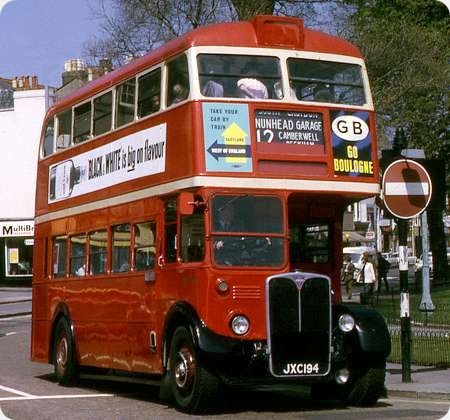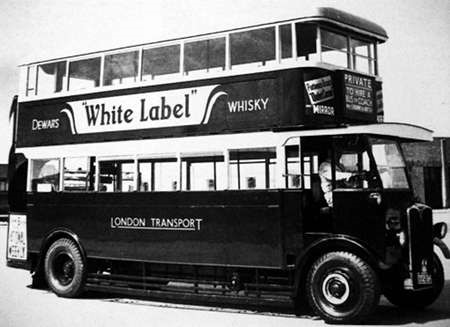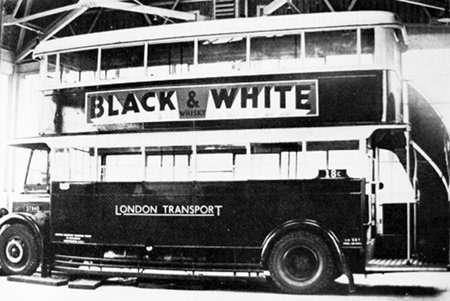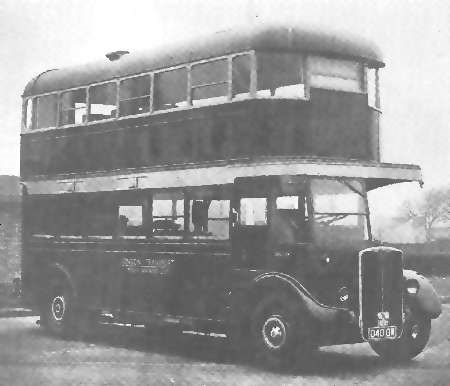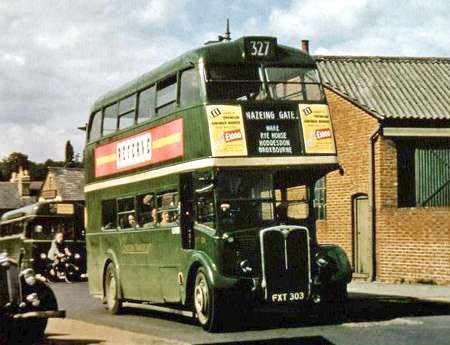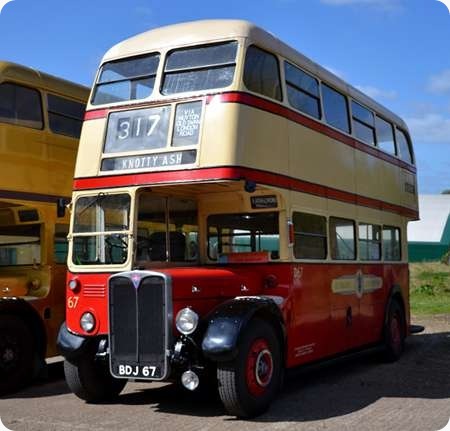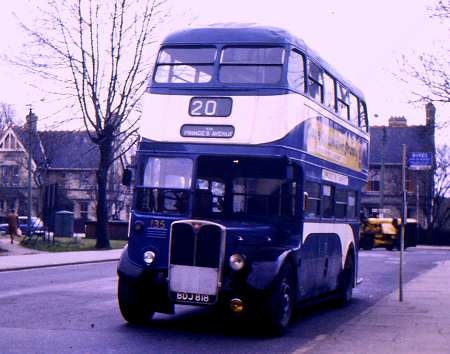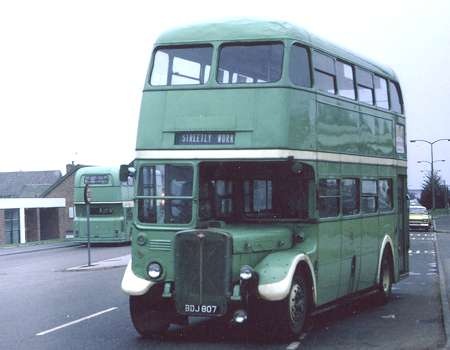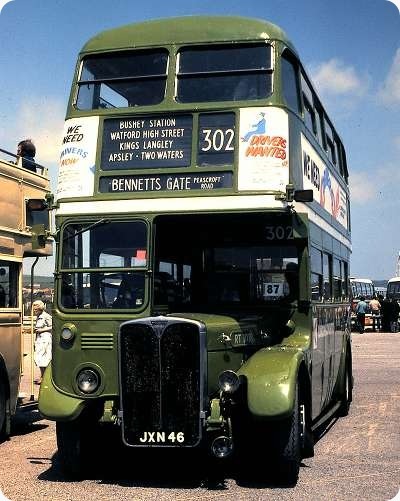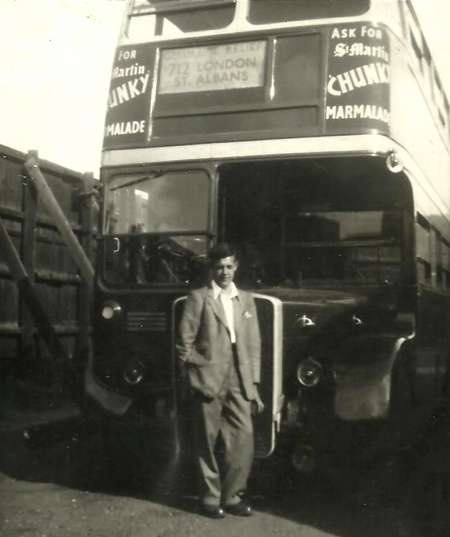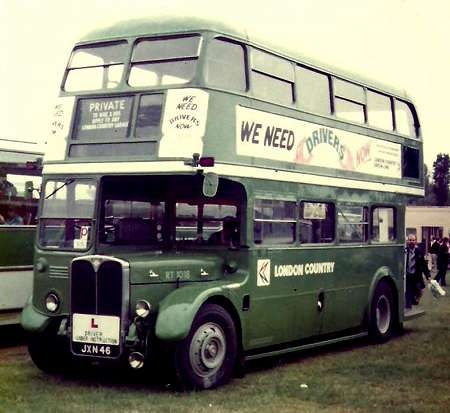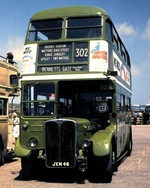London Transport – AEC Regent III RT – JXC 194 – RT 1431
London Transport
1949
AEC Regent III RT
Craven H30/26R
After operational trials with the revolutionary new chassis during 1938, initially equipped with a 1932 vintage open staircase ST body, the RT prototype re-appeared in August 1939 with an advanced all metal body of very graceful appearance built by Chiswick. An order was placed for 150 of the modern double decker, which was almost immediately raised to 338, with production of 527 each year from 1940 onwards being intended, though the ultimate envisaged total is not recorded. Then came WW2 and the sudden curtailment of bus production, though the order for the first 150 was completed. These, however, had Chiswick built composite bodies, presumably to conserve metal consumption during the hostilities, and the the last example entered service in 1942. With the end of the war, the RT programme was reactivated by AEC in 1946, by which time the chassis design had undergone several improvements, notably in the engine which now had toroidal cavity pistons increasing the maximum output from 100 bhp to 125 bhp, though LT derated this to 115 bhp in the interests of economy and extended life. The jig built metal framed bodywork programme for the RT took a while to establish, and the first postwar RT chassis from 1946 went to provincial operators who equipped them with standard contemporary bodies from their own suppliers. The LT RTs began appearing from 1947 with bodywork by Park Royal and Weymann, but chassis deliveries began seriously to outpace those of the bodywork manufacturers. In 1948, anxious to update its tired pre war fleet, LT turned to other bodywork constructors, selecting Saunders-Roe and Craven to make up the deficit. The Saunders body was metal framed using the firm’s own cruciform pillar design, but the end result outwardly resembled the standard Park Royal/Weymann product very closely. Indeed, the Saunders body was held by LT engineers to be of superior constructional quality, and, although Saunders received a second order for 50, making 300 in total, the unforeseen sharp decline in bus travel from the early 1950s meant that no others were built. The 120 Craven bodies were very different, being simply that manufacturer’s standard design married up to the RT cab and bonnet. The bespoke mountings meant that these bodies were not interchangeable with other RT chassis and this entire batch had to be overhauled separately at Aldenham. They were delivered between September 1948 and April 1950, the first twenty seven being painted green for the Country Bus & Coach department, and allocated to Watford and Windsor depots. The rest were red for Central Bus operation, and their allocation was spread about in seemingly random fashion. Ironically, from 1949, the supply situation went into reverse. RT chassis production could not keep up with the increased bodywork deliveries, and London Transport embarked upon the futile and very costly course of modifying some late STL chassis to accept standard RT bodies. Thus was born the SRT class which proved to be pitifully under powered with the 7.7 engine and dangerously under braked. After a service life of about four years they were all withdrawn, the chassis being scrapped, and the bodies transferred to new RT chassis. As bus patronage declined during the 1950s LT found itself with a significant fleet surplus of vehicles, large numbers of brand new RT and RTL deliveries going straight into store. (This, however, did not deter LT from investing heavily in its new Routemaster for which, at the time, there was no operational necessity.) With large numbers of new RTs and RTLs waiting to take to the road, the non standard Craven RT fleet was earmarked for early withdrawal and most went into store during 1955/6, only for twenty red examples to be repainted green for Country Area service in March/April/May 1956. They did not last long, being withdrawn again between one and four months later, the expensive repainting exercise being yet another example of LT profligacy. At merely six to eight years old, the Craven RTs, became bargain purchases on the secondhand market, going on to serve their new owners for up to a further thirteen years, proof, indeed, that the Craven body design was entirely sound. RT 1431 was delivered to LT in May 1949 and sold out of stock on 30 April 1956 to the dealer, Bird’s of Stratford upon Avon, being very quickly bought by a member of the Ardrossan A1 Service, who ran it for ten years. Early in 1966 this bus was secured for preservation, and the picture shows it at Brighton during the 1970 HCVC Rally. The destination display has been reduced to represent the situation that prevailed in the early 1950s when linen for bus blinds was in short supply. Since 2004, RT 1431 has been a member of the Ensignbus fleet.
Photograph and Copy contributed by Roger Cox
06/07/21 – 05:59
I always found the flatter and less rounded sides of the Craven RTs front to be more attractive than the standard RT body, but the rear was pure Cravens, with its curved upper deck, lower window and number plate positions.
RT 1 was initially given the Christopher Dodson body of ex-City Leyland Titan TD111, dating from 1931. It then became ST1140; all very confusing!
Here are two photos of ST1140, which are quite rare
Chris Hebbron
07/07/21 – 05:58
I just like them as buses – but equally like the "standard" RT design. The Cravens were my favourites of the 100 9612Es delivered to Sheffield Transport between 1947 and 1950. They were among the last in 1949/50. Good looking buses with a long life. Excellent though they were, the Weymanns had a permanent scowl which detracted from their appearance. Strangely enough, the lowbridge version (eg RLHs) had a more balanced and appealing appearance – not a thing said very often of lowbridge buses.
David Paul Oldfield
25/07/21 – 07:18
I believe that fitting the old body onto the new RT1 and disguising it as ST1140 was with the intention of fooling competitors into thinking that it was just another old London type.
But as the body came from a TD class, which was filled with various acquired Leyland TD1s [and some TD2s?], I wonder how much modification was needed to make it fit? The wheelbase would surely have been different, yet the image above of ST1140 as fitted does not look out of proportion, or crude in any way. This must have been rather an expensive refit for such a short time before the modern body was fitted.
Michael Hampton
26/07/21 – 07:09
Good points, Michael. The Leyland TD1/TD2 was the largest class taken over from the independents by London Transport, not far short of 200. The almost new ones from 1931/33 had modern bodies by Christopher Dodson/Birch Bros. Many of the class finished up with Liverpool Corporation, painted grey and used for ferrying employees to/from sensitive sites. Incidentally, I’ve found another, poor, but mystery, photo of ST1140, posing as some sort of mobile unit, with spats on rear wheels, plus front side lights with reduced lighting area: wartime mode. Yet RT1 was in service with its new body, pre-war, in mid 1939!!
Chris Hebbron
27/07/21 – 06:37
Several interesting comments here, and thanks, Chris, for those pictures of AEC/LPTB’s ‘Q ship’, ST1140, surely devised to fool the competition (Leyland) whilst the new chassis was being tested in service. As Michael has hinted, the disguise of an old open staircase body from a TD1 might well have been decided by the wheelbase. The early Regents of the ST class had a wheelbase of 15ft. 6.5 ins, which was slightly curious because Rackham had only just left Leyland where his new TD1 Titan had been designed with a wheelbase nearly a foot longer at 16ft. 6ins. From 1932 the Regent had a wheelbase of 16ft. 3ins, but none of the later LPTB examples had such elderly looking bodywork that must surely have been deliberately chosen to camouflage the new beast. The new RT chassis – certainly not yet known as the Regent III – had a wheelbase of 16ft. 4ins, for which the old Dodson body must have been adaptable. Chris’s latest picture is a bit of a puzzle because RT1 was fitted with its new Chiswick built body in April 1939, so what is it up to in that photo? The threat of war had been hanging over Britain certainly since 1938 when huge production of war material such as Hurricanes, Spitfires and bombers was initiated, so perhaps ST1140 was used in its final days as a test bed for wartime specifications.
Roger Cox
27/07/21 – 06:39
Actually, now that all three photos are together, and comparison of the first two with the bottom one is possible, it is quite clear that the body on bottom photo is quite different, bearing all the hallmarks of a Tilling/Dodson body from an ex-Tilling ST, some of which started to be withdrawn in the immediate pre-war period. Although body sag might not have been apparent on these frail bodies in 1939, there is no trace of it, nevertheless. What’s all this about???
Chris Hebbron
29/07/21 – 06:25
Thank you Roger for your note on the wheelbase dimensions of the related chassis here. I can quite see how the two inches difference between a TD1 and the RT prototype would be quite easily dealt with in LT’s workshop without showing any obvious crudity. No doubt it was written up as a "research and development" expense, along with everything else that was involved. I had thought that there would have been a very different wheelbase dimension between a TD1 and an RT – but my assumptions have been proved wrong! I was surprised by the difference between the first Regents and the TD1, as they were more or less contemporary in design and production. That seems even more puzzling, but no doubt it’s another story to be told on another occasion.
Michael Hampton
11/08/21 – 05:45
It’s worth noting that RT1’s new Chiswick body had a seating capacity of H29/26R suggesting that it would have breeched the gross vehicle weight limit in force at that time if the standard H39/26R capacity was used.
The gross vehicle weight limit was relaxed during the war and again after the war.
Michael Elliott
17/08/21 – 06:30
I had not thought of it before, but some years ago it was pointed out to me that timber/composite rames were heavier than metal. The "Prewar" RT1-150 were of composite construction, unlike the post war bodies. It is likely that they might be heavier and that certification require fewer seats.
David Oldfield
18/08/21 – 05:52
You are probably generally right about the weight of timber frames versus metal frames. But I have a feeling that in the case of the RT family, the "pre-war" ones, [RT2-151] were actually lighter than the post-war version. I have a memory that some of the pre-war machines were kept in service for a longer period than most of the batch due to their allocation for a route over a weight-limited bridge or similar structure. The post-war ones deemed as too heavy. I cannot now remember what route it was, but think it was the outer London suburbs, north of the Thames. I assume that the offending structure was rebuilt or the route diverted when the time came to withdraw these last few pre-war RTs.
Michael Hampton
21/08/21 – 06:15
It was Country Area route 327 that used them.
Ian Mason
22/08/21 – 06:22
Yes, Ian is correct. The Hertford garage based 327 route between Nazeing and Broxbourne crossed a weak bridge over the railway. This service was one of the last strongholds of the postwar STL class until they were displaced in May 1955 by seven wartime RTs, with engineering backup from a couple of others, one in red livery, that served as trainers but still had full psv certification. The Chiswick composite constructed body of the wartime RT had an unladen weight of 6 tons 15 cwt, significantly less than the 7 tons 10 cwt of the Park Royal or Weymann bodied standard RT. When the bridge was suitably reinforced, these RTs were withdrawn in August 1957. I acknowledge Ian’s Bus Stop for padding out my memory with accurate dates.
Roger Cox
22/08/21 – 06:23
There were seven of them, RTs 36, 62, 79, 93, 114, 128 and 137, nicknamed "The Magnificent Seven!". They were all re-painted into green and based at Hertford Garage from 1955 to 1957. Some had full blinds, even the route number box, but some had one-piece ex-STL blinds. All, bar one, lasted until 1963, some finishing as learner vehicles or as Aldenham hacks. Postwar RTs weighed in at 7.5 tons if memory serves, but the wartime ones were definitely lighter.
Chris Hebbron
25/08/21 – 05:52
Here’s a photo of Green RT 128, fully blinded, on route 327.
Chris Hebbron
03/10/21 – 17:23
The vehicle shown in Chris Hebbron’s picture of 26 July is not RT1 (aka ST1140) with its Dodson body. It is an early postwar 3RT chassis, 0961079, new in 1947 which was used as a training chassis for, I believe, the depot engineers.
Because chassis production at the time was outstripping body production, it was evidently decided to use a secondhand body, and the Tilling body from ST977 was fitted. The vehicle was known by its chassis number and never had a Service Vehicle number.
It lasted in this role until 1953 when the body was scrapped and the chassis emerged with a new Weymann body in 1954 as RT4761. However it was stored until 1958 and the chassis was eleven years old when it finally entered passenger service.
Basil Hancock
05/10/21 – 06:12
Thanks, Basil, for clearing up the mystery of my 26th July posting. What an extraordinary history of the chassis, taking 11 years before it finally appeared in revenue-earning service as RT4761 And a Tilling ST body fitted here without any sag!!
Chris Hebbron
06/10/21 – 06:19
RM8 took even longer, not entering passenger service until 1976 when it was 18 years old. This made it the last rear entrance and the last half-cab double decker to enter service in the UK, although it was not exactly new at the time.
And just to add to the statistics, Chiswick Experimental RT3995 only operated in passenger service for three months before becoming Chiswick’s new toy. Even Merlins and Fleetlines lasted longer than that.
Here are two photos of the former Chiswick Experimental RT3995 in service with Spencers in High Wycombe on 3 November 1969.
I am not sure who did the rear end modification, but it looks quite professional so it might have been LT themselves.
Basil Hancock
07/10/21 – 06:27
Interesting about RM8, Basil. RT3995 looks very well turned-out, but looks a little odd with that style of enclosed platform. Thx again for letting us know about these sorts of oddities, otherwise lost over the years.
Chris Hebbron
10/10/21 – 19:27
RT1431 was strutting her stuff between Dorking and Putney Heath on the 93 running day yesterday (9 October) – along with RT1 and sundry other members of the RT and RM class. RTs predominated and most of the buses were "showroom" condition – a testament to the hard work and care lavished on them by their owners. I’ve said it before but, Three cheers to the preservationists who continue to make these events possible.
David Oldfield
11/10/21 – 20:26
Wish I could’ve gone, David. Living at Morden until 1956, the 93 was our long-distance through-route, initially served exclusively by 1RT1s, but Sutton’s D’s would later put in an appearance and Merton’s STL’s and D’s would appear on the Summer Sunday extension from Morden to Dorking, when I’d persuade my mum to splash out for a ride into the country and green buses! In those days, that whole journey was in Surrey!
Chris Hebbron
Quick links to the - Comments Page - Contact Page - Home Page
